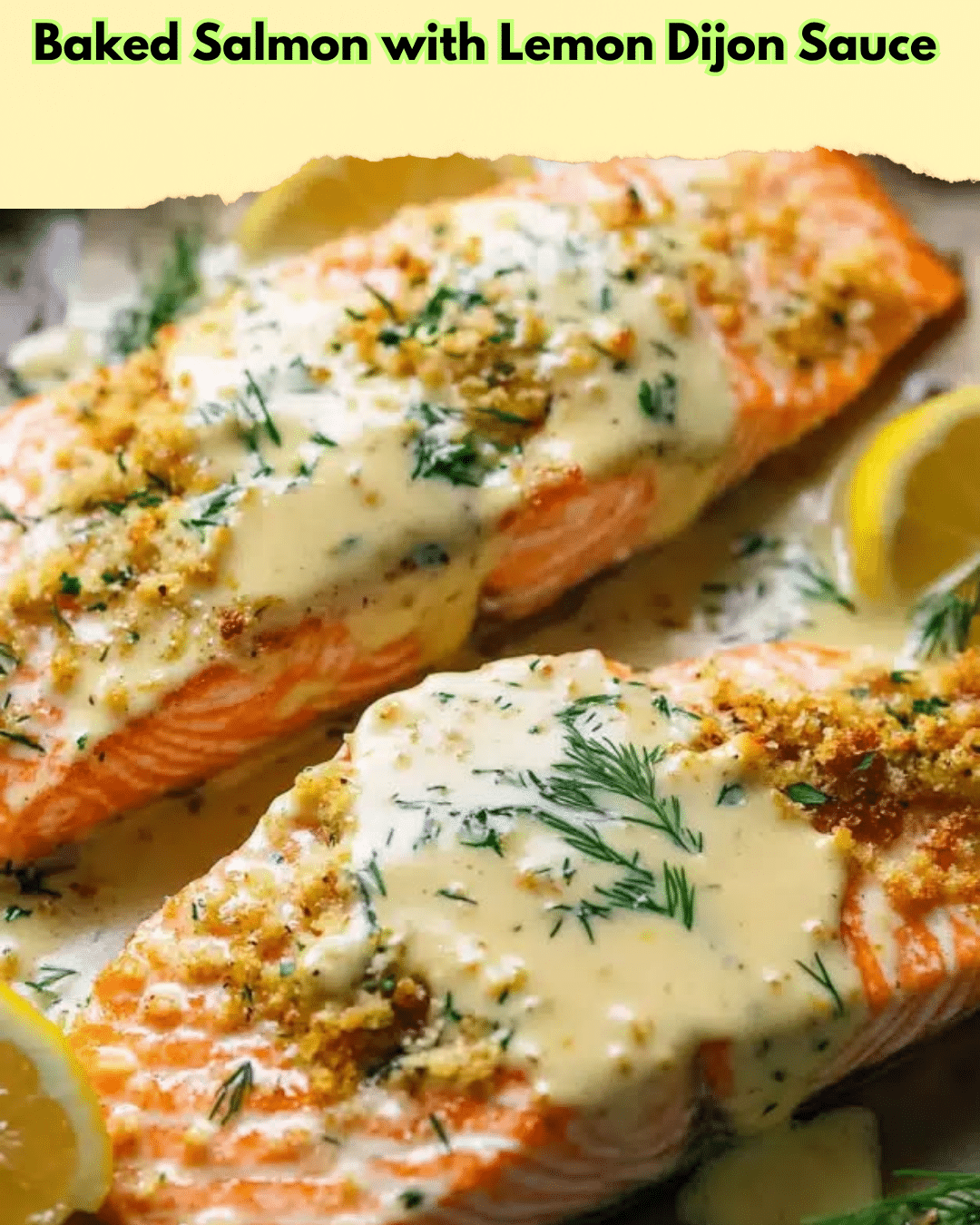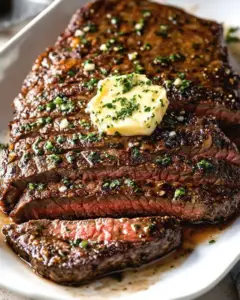Baked Salmon with Lemon Dijon Sauce: A Delightful Seafood Experience
Discover the art of cooking perfect Baked Salmon with Lemon Dijon Sauce, combining the essence of tangy citrus with the subtle spiciness of Dijon mustard. This delightful dish is an easy yet sophisticated option for seafood lovers. The flavors of the fresh salmon fillet harmonize perfectly with the vibrant lemon Dijon sauce, providing a burst of zest and savory depth in every bite. Whether you’re looking for a quick weeknight dinner or an impressive meal for guests, this recipe promises an elegant dining experience that’s both nutritious and satisfying.
Experience the unparalleled taste of oven-baked salmon paired with a luscious lemon Dijon sauce. This dish delivers a harmony of textures—succulent and flaky salmon enveloped by a rich, creamy sauce. The fresh, herbaceous notes scattered throughout enhance the dish’s complexity, while the zesty lemon imparts a refreshing contrast to the rich, buttery elements. Perfectly cooked salmon showcases its naturally tender and juicy texture, ensuring that each bite melts in your mouth, leaving a lingering taste of culinary delight.
Quick Recipe Highlights
- Flavor Profile: A perfect blend of tangy, spicy, and savory with a hint of herbaceous freshness.
- Texture: The salmon is tender and juicy, complemented by a velvety, smooth sauce.
- Aroma: A fresh and enticing aroma of citrus mingling with the warm scent of baked salmon and a hint of garlic.
- Visual Appeal: An attractive presentation with vibrant colors and a glossy, cream-hued sauce.
- Skill Level Needed: Requires basic cooking skills with attention to detail for the sauce preparation.
- Special Equipment: Chef’s knife, baking dish, whisk, zester, and a sharp peeler for perfect results.
Recipe Overview
- Difficulty Level: This Baked Salmon with Lemon Dijon Sauce is medium difficulty, as it involves techniques like making emulsifications and baking to the right degree of doneness.
- Category: Ideal for a main course in either a family meal or a formal dinner setting, thanks to its versatile appeal and rich taste.
- Cuisine: A refinement of Western cuisine, subtly influenced by classic French cooking techniques that focus on enhancing salmon’s natural flavors.
- Cost: Relatively affordable, with salmon being the primary expense; overall, it’s budget-friendly for such an exquisite dish.
- Season: Best served in spring and summer when lemons are freshest, making it a fantastic option for warmer days.
- Occasion: Suitable for intimate gatherings, date nights, or even festive occasions when you wish to impress your guests with minimal effort.
Why You’ll Love This Recipe
Start with the succulent flavor profile of baked salmon enhanced by the creamy lemon Dijon sauce. Its complex yet balanced flavors tantalize the palate with tangy, spicy, and savory notes. The sauce’s silkiness juxtaposes the salmon’s crisp exterior, creating an unforgettable texture experience.
Convenience is key with Baked Salmon with Lemon Dijon Sauce. With minimal prep and cook time, you can have an elegant dish on the table quickly. Its straightforward instructions suit novice and seasoned cooks alike, making it an ideal weeknight meal without compromising on sophistication.
Nutritionally, this dish is spectacular. Salmon is high in omega-3 fatty acids, promoting heart health, while the lemon adds vitamin C and antioxidants. This is a healthy choice, aligning taste with a nutritious lifestyle—perfect for anyone focusing on wellness.
This recipe is a social spectacles, ideal for entertaining. Its look and aroma captivate before reaching the plate, sparking conversations and delicious moments. Your guests will appreciate the thought and flavor surrounding their dining experience.
Cost-effectiveness is a bonus. While salmon may be a premium ingredient, pairing it with simple yet flavor-packed components like lemon and Dijon mustard keeps costs manageable without sacrificing taste or impact, making luxury accessible for any occasion.
Historical Background and Cultural Significance
The recipe originates from the rich culinary traditions of France, where Dijon mustard has been a staple since the 1850s. This mustard’s evolution was pivotal in developing countless classic sauces and dressings, particularly in pairing with seafood.
In France, salmon has historically played a key role in regional cuisines, particularly along the rivers where it was once abundant. Baked Salmon with Lemon Dijon Sauce is one such dish that has evolved to highlight local produce’s vibrancy and versatility.
Over time, this recipe has adapted to regional materials and tastes, increasing its popularity beyond France. Its adaptability to fresh, local products makes it a sought-after dish worldwide, celebrating region-specific flavors and culinary creativity.
Various regions have put their own twist on Baked Salmon with Lemon Dijon Sauce. In Mediterranean countries, olives and capers may be introduced, while Nordic countries might include dill. Each variation celebrates the global appreciation for this recipe and showcases its universal appeal.
Ingredient Deep Dive
Salmon, a cornerstone of this recipe, offers immense nutritional advantages, being rich in omega-3 fatty acids. Choose fresh, sustainably-sourced salmon for best flavor. Ensure it has a glossy, firm texture with a fresh sea aroma. Keep salmon refrigerated and consume promptly for optimal quality.
The zesty lemon is crucial in providing that bright, tangy kick, cutting through the richness of the dish. A rich source of vitamin C, lemons play a supporting role in both flavor and nutrition. Store them in a cool, dry place, and select those with a vibrant yellow hue for juiciness.
Dijon mustard imparts a distinctive, savory spice to the sauce, elevating the salmon’s natural flavors. Originating from Dijon, France, this mustard adds depth to many dishes. Keep refrigerated after opening to preserve freshness and flavor.
Butter adds a luxurious creaminess to the sauce, accentuating the richness typical in French-inspired cooking. It’s best to use unsalted butter for controlling sodium levels. Store butter in a covered dish in the fridge to maintain its quality and prevent absorption of other flavors.
Garlic, an aromatic powerhouse, infuses the sauce with a robust undertone, enhancing the overall aura of the dish. Fresh garlic cloves offer the best flavor; choose firm, unblemished cloves with tight skins. Store in a cool, dry place to prolong shelf life.
Common Mistakes to Avoid
- Avoid overcooking the salmon as it can result in dry texture; aim for an internal temperature of 145°F (63°C).
- Don’t underestimate the importance of preheating your oven for even cooking.
- Ensure your mustard and lemon are fresh for the most vibrant sauce.
- Use a reliable oven thermometer to avoid incorrect temperature readings.
- Pat your salmon dry before baking to achieve a desirable, crispy finish.
- Don’t overcrowd your baking dish; ample space ensures even cooking.
- Refrain from adding too much salt early on; adjust seasoning after the sauce has cooked.
- Avoid using old garlic, which can impart a bitter taste.
Essential Techniques
Master the art of emulsifying for a silky lemon Dijon sauce. Gradually whisk in butter, allowing each piece to fully incorporate before adding more, creating a smooth, stable sauce. Look for a glossy appearance as a success indicator.
Perfect doneness is crucial in baking salmon. Use a digital thermometer to avoid overcooking. Visual cues, such as opaque flesh and easy flaking with a fork, signal readiness. Practice patience for perfect results.
Zesting lemons must be done lightly, avoiding the bitter white pith. Use a microplane for fine zest, maximizing flavor extraction. Keep a gentle touch and rotate the fruit for even zesting.
Pro Tips for Perfect Baked Salmon with Lemon Dijon Sauce
For a savory depth, marinate the salmon briefly with herbs and lemon zest before baking. It infuses the fish with nuanced flavors, enhancing the overall dish.
Balance sauce acidity by tasting as you go. If lemon is too overpowering, incorporate more butter to mellow the flavors, achieving harmonized taste.
Creating a crispy salmon skin is an added textural delight. Always pat the skin dry before seasoning and baking. High heat ensures that coveted golden, crisp finish.
When baking, position salmon centrally in the oven for uniform heat distribution. This helps in achieving even cooking and maintains the delicate texture.
Enhance the dish’s flavor profile with fresh herbs such as dill, thyme, or parsley. These add an aromatic lift and visual appeal, tying the plate together elegantly.
Always allow the salmon to rest briefly after cooking. This crucial step helps retain moisture, allowing the juices to redistribute, ensuring a tender, juicy texture.
Variations and Adaptations
For a Mediterranean twist, add a sprinkle of feta cheese and fresh oregano before serving. These ingredients complement the lemony sauce with distinct depth and richness, reminiscent of sunny coasts.
Adopt a seasonal approach by incorporating ingredients such as asparagus in spring or roasted root vegetables in fall. They naturally complement the salmon and sauce.
For those on a low-carb diet, substitute traditional sides for leafy greens or cauliflower mash, ensuring low carbohydrate intake without losing satisfaction and flavor.
Varied mustard types, such as whole grain or spicy brown, introduce new flavors into the mix. Experiment to find a balance that suits your palate and dietary preferences.
Embrace creamier sauce textures by incorporating heavy cream. This creates indulgent results suited for those seeking richer flavors, while keeping the core lemon and Dijon essence intact.
Elevate presentation with colorful garnishes such as edible flowers or microgreens. These additions enhance the visual appeal and offer subtle flavor contrasts.
Serving and Presentation Guide
Master plating elegance by arranging salmon atop a bed of lightly dressed arugula. The greens provide vibrancy and a peppery balance to the rich, acidic sauce.
Enhance visual allure with a scattering of vibrant pomegranate seeds or thinly sliced radishes. Their pop of color and crunch add refreshment to each bite.
Traditionally accompany this dish with dill-infused new potatoes or a side of roasted vegetables. These provide textural contrast and flavor harmony.
Modernize with an artful drizzle of the sauce over the salmon. This keeps aesthetics streamlined and emphasizes the dish’s sophisticated simplicity.
Mind temperature—serve the dish warm, not piping hot, to appreciate balanced flavors and avoid palate fatigue, ensuring your guests fully savor every element.
Portion wisely, serving around 6 oz (170 g) of salmon per person for a generous, but not overpowering, single serving.
Wine and Beverage Pairing
Pair Baked Salmon with Lemon Dijon Sauce with a crisp, acidic white wine like Sauvignon Blanc. Its citrus notes amplify the lemon while cutting through the sauce’s richness, creating a harmonious blend.
For non-alcoholic options, consider a sparkling water with a twist of lemon or lime. It refreshes the palate and aligns with the dish’s zesty undertone.
If coffee or tea is preferred, opt for herbal or citrus blends without overpowering flavors. These offer warmth during colder months without disrupting the dish’s taste profile.
Attention to wine’s serving temperature—aim for chilled whites and sparklings, slightly warmer reds, to appropriately complement the salmon and retain their aromatic and flavor characteristics.
Strongly consider serving suggestions for portion sizes to ensure neither beverage nor dish overwhelms, but rather enhances, the full enjoyment of your culinary efforts.
Storage and Shelf Life
Utilize airtight containers when storing leftovers, ensuring freshness. Keep salmon and sauce separate for optimal quality, maintaining the sauce’s texture and preventing salmon flavors from saturating the mix.
Refrigerate at 40°F (4°C) or below, consuming within 2-3 days. Look for quality retention over extended storage times by reheating only what you need.
Ensure storage containers are BPA-free to maintain health standards and flavor integrity, allowing you to enjoy safe and tasty leftovers with confidence.
Signs of spoilage include discolored flesh or a sour odor. Discard if detected to prevent health risks.
Reheat gently in a low-temperature oven for even warming, keeping flavors intact, or utilize a steam method for moisture retention.
If freezing is necessary, do so at peak freshness. Properly wrapped, salmon remains viable for up to 2 months. Thaw thoroughly in the refrigerator before reheating to avoid textural changes.
Make Ahead Strategies
Prep the lemon Dijon sauce ahead and refrigerate, reheating gently before use. This convenience ensures streamlined assembly when time is of the essence.
Maintain quality by storing sauce and cooked components separately until just before serving. This tactic prevents sogginess and flavor loss, keeping dishes fresh.
Assess the impact of refrigeration time on sauce and fish to avoid compromise in flavor or texture. Fresh additions just before serving keep taste optimal.
Expertly reheat pre-cooked elements, reducing heat exposure to retain moisture and original texture. Accuracy in this step ensures every serving feels freshly made.
Incorporate fresh herbs or lemon zest last for a burst of fragrance and color, contrasting pre-prepared elements while enhancing overall taste.
Facilitate organized execution by planning a sequential workflow. Strategic timing ensures maximum quality and presentation impact, with all steps seamlessly connected for enjoyable dining.
Scaling Instructions
For smaller gatherings, halve the recipe, ensuring regular salmon portions and adjusted seasoning. This maintains flavor strength across reduced quantities.
Doubling or tripling requires balanced adjustments—consider cooking in batches for even quality and avoid overcrowded pans to avoid uneven texture.
Adjust equipment, utilizing larger baking dishes or additional ovens for increased quantities. This guarantees efficient cooking with consistent, uniform results throughout.
Timing modifications may be necessary with increased amounts. Closely monitor doneness signals to prevent overcooking, particularly in larger batches where temperature can vary.
Ensure plentiful storage space for surplus ingredients, keeping at peak quality and ready for use. Opt for cohesive packaging to facilitate adjustments without compromising taste or texture.
Nutritional Deep Dive
Dive into the macro balance with moderate protein and healthy fats from salmon, aligning taste satisfaction with dietary needs. Perfect for individuals targeting muscle retention.
Explore micronutrient benefits in this dish, with omega-3s from salmon and vitamin C from lemons enhancing the immune system and reducing inflammation.
Health benefits align with low-calorie intake without skimping on essential nutrients. A single serving promotes weight management while encouraging a balanced dietary approach.
Consider dietary inclusivity for varied needs, from low-carb to heart-healthy lifestyles. This dish supports diverse nutritional approaches and encourages overall wellness.
Analyze portion sizes for nutritional needs. The controlled balance ensures suitability for weight management, and can be adjusted based on individual energy output.
Dietary Adaptations
For a gluten-free option, ensure all elements are free from cross-contamination. The dish naturally appeals to gluten-sensitive diners, complementing dietary requirements.
Dairy-free adjustments involve substituting butter with plant-based alternatives. This approach retains flavor richness while accommodating lactose-free lifestyles.
Opt for vegan adaptations by replacing salmon with firm tofu or tempeh and utilizing nutritional yeast in the sauce. This method maintains the dish’s flavorful essence without animal products.
Low-carb modifications align with ketogenic diets. Pair with leafy greens and minimal carbs for a satisfying meal consistent with carb-control goals.
Paleo-friendly, salmon and lemon Dijon sauce can be adapted with grain-free ingredients for those following this ancient diet approach, preserving natural ingredient integrity.
Low-FODMAP considerations focus on appropriate portion sizes and limit high-FODMAP components to ensure this dish supports digestive health for those with sensitivities.
Troubleshooting Guide
Address texture issues by paying close attention to oven temperature, ensuring even heat for perfect salmon consistency. Experiment with lower temperatures for tender outcomes.
Flavor balance adjustment involves fine-tuning seasoning as you go and applying strategic bursts of acid or sweetness to counteract imbalances and harmonize flavors.
Temperature problems may occur; invest in a reliable thermometer and calibrate regularly, ensuring exactitude in cooking and food safety.
Manage equipment challenges by maintaining clean, well-functioning tools for consistent results. Regular maintenance and assessment streamline workflow and prevent deviations.
Ingredient substitutions require a nuanced approach, experimenting cautiously to maintain the core recipe’s structure while introducing dietary flexibility where needed.
Reconsider timing concerns through careful monitoring of cooking phases, reducing stress by planning preparation and execution with precision and coordination.
Recipe Success Stories
Community feedback often highlights personalized touches, with success stories ranging from unique plating to adaptation suggestions. Share your creative efforts for inspiration!
Variation successes showcase global enthusiasm. Readers have reported triumphs with regional ingredients, including capers and olives, yielding new flavors and celebrations of diverse culinary experiences.
Adaptation stories highlight how everyday ingredients can be seamlessly introduced for captivating results. Join in by offering your unique twists on this versatile recipe.
Reader suggestions often include delightful pairing ideas—from side dishes to beverages—and innovative techniques, enhancing the experience further through crowd-sourced enhancement.
Enhance your photography of this dish with tips from seasoned bloggers, capturing the vibrant colors and textures through thoughtful composition choices, elevating online presentations.
Frequently Asked Questions
Q: Can I use frozen salmon for this recipe?
A: Absolutely, but ensure it’s appropriately thawed. Frozen salmon retains quality if gently defrosted in the refrigerator overnight before cooking.
Q: What can I substitute for Dijon mustard?
A: Whole grain or spicy brown mustard makes good substitutes, offering different flavor nuances to suit individual preferences and availability.
Q: How can I prevent my sauce from curdling?
A: Consistently whisk in the butter slowly over low heat to prevent separation, which helps maintain smooth and emulsified sauce consistency.
Q: Can the sauce be made ahead of time?
A: Yes, prepare it in advance and store it chilled. Reheat gently while whisking to revive its creaminess prior to serving.
Q: Is it necessary to flip the salmon while baking?
A: Flipping isn’t necessary. Baking slightly longer with skin-side down preserves moisture and integrity.
Q: How can I determine if salmon is cooked perfectly?
A: Look for opaque flesh and ease of flaking with a fork. Use a thermometer to check that internal temperature reaches 145°F (63°C) for accuracy.
Q: What wine pairs well with salmon?
A: A crisp white wine like Sauvignon Blanc complements the citrus notes and maintains a refreshing, balanced palate while enjoying the dish.
Q: Should I serve salmon with the skin on or off?
A: Personal preference dictates this choice—skin retains moisture, offering a lovely crispy texture when left intact and properly prepared.
Q: How should I reheat leftovers without compromising flavor?
A: Warm gently in a low oven (around 275°F/135°C) until heated through, or use steaming to revive moisture and texture.
Q: How do I ensure an even sauce flavor?
A: Taste consistently while cooking, adjusting seasoning and acidity levels carefully for harmonious integration.
Q: Can this dish be frozen for future meals?
A: It’s best enjoyed fresh, but can be frozen if necessary. Thaw in the refrigerator prior to reheating for best results.
Additional Resources
Discover related recipes such as Lemon Herb Grilled Salmon or Dijon Crusted Chicken for additional flavorful offerings, expanding your repertoire with complementary dishes.
Technique guides focusing on perfecting emulsified sauces provide detailed steps and troubleshooting tips, empowering you to master this skill with confidence.
Ingredient information includes sourcing guides for high-quality, sustainable seafood, ensuring each element of your dish meets ethical and flavor expectations.
Invest in quality equipment recommendations like digital thermometers or nonstick baking sheets to simplify cooking processes and elevate meal prep outcomes.
Embrace seasonal variations with content that aligns ingredients with peak availability for year-round enjoyment, maximizing freshness and local sourcing benefits.
Print
Baked Salmon with Lemon Dijon Sauce
Description
A delightful and easy-to-make salmon dish with a tangy lemon Dijon sauce.
Ingredients
For the Crust:
- 4 salmon fillets
- 2 tablespoons Dijon mustard
- 1 lemon, juiced
- 2 tablespoons olive oil
- Salt and pepper to taste
Instructions
1. Prepare the Crust:
- Preheat oven to 400°F (200°C). Prepare a baking dish by lightly greasing it.
- In a small bowl, whisk together Dijon mustard, lemon juice, olive oil, salt, and pepper.
- Place salmon fillets in the baking dish and spread the lemon Dijon mixture evenly over them. Bake for 25-30 minutes, or until the salmon is cooked through and flaky.
Notes
You can customize the seasonings to taste.




